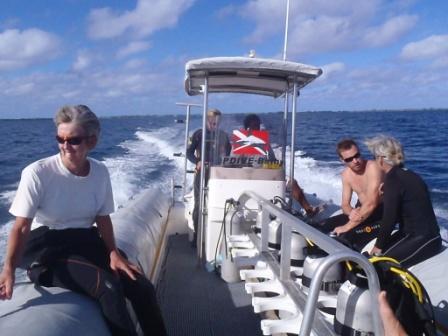Diving

VulcanSpirit
Richard & Alison Brunstrom
Sat 16 Jun 2012 17:11
|
Fakarava and several surrounding atolls have been
declared by France and the UN as a UNESCO World Biosphere Reserve because of the
amazing marine life from humpback whales to coralline algae. And it really is
spectacular; we've used our recent recertification as divers to go out with
TopDive, one of the very friendly French dive businesses. The water in
the lagoon itself is not very clear, but outside on the reef and in the passes
it is beautiful - 30-40m visibility (which is a lot, better than a swimming
pool). The reef is in extremely good condition, the bottom literally covered in
live healthy corals and a quite unbelievable number and range of fish whose
colours are just stunning.
You have to be very careful with your diving depth
here. The water is 1000m deep just a few hundred metres from the shore, and it
is so enticingly clear that it is very very easy to descend too far due to the
lack of visual clues (using compressed air we are limited to an absolute
maximum safe depth of just thirty metres). A close watch on the depth gauge
(one's only reference) is essential.
Unfotunately we don't (yet) have a camera suitable
for diving but I'll try to get some photos from our friends who do. It is
just amazing, like swimming in a giant aquarium stuffed full of fantastic and
garishly coloured fish. In the meantime, here is the other half of the crew on
her way to a dive earlier today:
 We're screaming across the lagoon at about 30kts in
the TopDive RIB (rigid inflatable boat), a quite ridiculous speed for us old 5kt
cruisers. You can just see the main island in the background. Note that although
it's only about 5km away even the tops of the trees have nearly disappeared over
the horizon. The hunky guy on the right is the new French dive instructor who
has just arrived here for a five month stint; not bad work if you can get
it.
And here she is again, just about to go in (you
roll off backwards). Divers might note that the tank is clearly labelled
"NIT....". This is the start of 'nitrox', an air derivative that has less
nitrogen and more oxygen enabling a diver to stay down longer without risking
the bends (nitrogen bubbles in the blood, potentially crippling or fatal) but
for which special training is required which we have not had. But it's an old
label; her tank is actually full of air (you can see the newer "AIR 21" label at
the top of the tank, indicating that it is compressed air, with 21% oxygen) -
just one of the many things to think about when diving!
 |